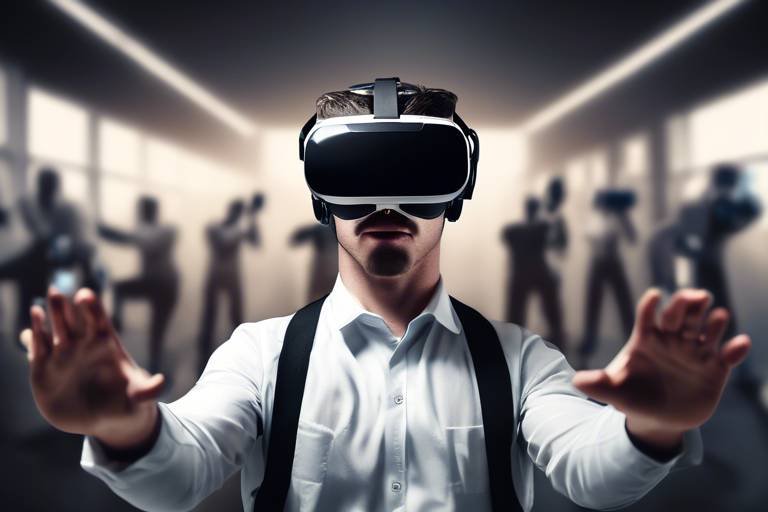The Role of AI in Enhancing Accessibility
In today's fast-paced world, the integration of artificial intelligence (AI) into our daily lives is not just a trend; it's a revolution. One of the most profound impacts of AI is its ability to enhance accessibility for individuals with disabilities. Imagine a world where everyone, regardless of their physical or cognitive abilities, can seamlessly navigate their environments, access information, and communicate effectively. AI is paving the way for this vision, acting as a bridge that connects people with the tools and resources they need to thrive.
AI technologies are rapidly evolving, and their significance in enhancing accessibility cannot be overstated. From speech recognition to text-to-speech systems, AI is transforming how individuals with disabilities interact with their surroundings. The advancements in these technologies are not merely about convenience; they represent a fundamental shift towards inclusivity. For instance, consider the impact of AI on a person with a visual impairment. With the help of text-to-speech applications, they can access written content that was once out of reach, empowering them to engage with the world in ways that were previously unimaginable.
Furthermore, AI is not just limited to assistive technologies; it extends to various sectors such as education, healthcare, and employment. In educational settings, AI-driven tools can tailor learning experiences to meet the needs of students with disabilities, ensuring that they receive the support necessary to succeed. Similarly, in healthcare, AI can assist in monitoring patients with disabilities, providing timely interventions that enhance their quality of life.
As we delve deeper into the role of AI in enhancing accessibility, it's essential to recognize that this technology is a double-edged sword. While the benefits are substantial, there are also challenges and limitations that we must address to ensure that AI remains a force for good. In the following sections, we will explore the various applications of AI in assistive technologies, the benefits it brings, and the hurdles that still need to be overcome. Together, we can work towards a future where accessibility is not just an afterthought but a fundamental right for all.
- How does AI improve accessibility for individuals with disabilities?
AI enhances accessibility by providing tools that assist in communication, navigation, and information access, enabling individuals with disabilities to interact more effectively with their environments. - What are some examples of AI applications in accessibility?
Examples include speech recognition software, text-to-speech systems, and voice-activated assistants like Siri and Alexa, which help users perform tasks hands-free. - What challenges does AI face in enhancing accessibility?
Challenges include technology adoption barriers, biases in AI algorithms, and the affordability of assistive devices. - What is the future of AI in accessibility?
The future looks promising, with ongoing innovations expected to further enhance inclusivity and accessibility for individuals with disabilities.

Understanding AI and Accessibility
Artificial Intelligence, or AI, is revolutionizing the way we interact with technology, making it smarter and more intuitive. But what does this mean for individuals with disabilities? Well, AI is not just a fancy buzzword; it's a game changer that can bridge the accessibility gap for many. Imagine a world where technology understands your needs and adapts accordingly—that's the promise of AI in enhancing accessibility.
At its core, AI refers to computer systems designed to perform tasks that typically require human intelligence. This includes understanding natural language, recognizing patterns, and making decisions. With advancements in machine learning and natural language processing, AI is becoming increasingly adept at recognizing and responding to the unique challenges faced by individuals with disabilities. For example, AI can help someone with a visual impairment navigate their environment or assist a person with hearing difficulties in understanding spoken language through real-time transcription.
The significance of AI in accessibility extends beyond mere convenience; it empowers individuals to live more independently. By utilizing AI-driven tools, people with disabilities can access information, communicate effectively, and perform daily tasks with greater ease. Think of AI as a personal assistant that’s always there to lend a helping hand. These technological advancements can be particularly beneficial in various settings, including:
- Education: AI tools can provide personalized learning experiences for students with disabilities.
- Workplace: AI can facilitate communication and collaboration, making work environments more inclusive.
- Healthcare: AI-driven applications can assist in managing health conditions and improving patient care.
However, it's essential to recognize that the journey toward inclusivity is ongoing. While AI has the potential to create a more accessible world, it’s crucial to ensure that these technologies are designed with the needs of all users in mind. This means involving individuals with disabilities in the development process, testing for real-world applicability, and continuously refining the tools based on user feedback. By doing so, we can create an ecosystem where technology serves everyone, regardless of their abilities.
In summary, understanding the role of AI in enhancing accessibility is about recognizing its potential to transform lives. As we continue to innovate and push the boundaries of what technology can do, we must remain committed to fostering an inclusive environment that empowers every individual to thrive. After all, when we break down barriers, we open doors to a world of possibilities.

AI Applications in Assistive Technologies
Artificial Intelligence (AI) is revolutionizing the way individuals with disabilities interact with the world around them. The integration of AI into assistive technologies has opened up a realm of possibilities, enabling users to communicate, learn, and engage more effectively. From speech recognition to text-to-speech innovations, these technologies are designed to break down barriers and enhance the daily lives of those who rely on them.
One of the most exciting aspects of AI in assistive technologies is its ability to adapt to the unique needs of each user. For instance, AI-driven tools can learn from user interactions, improving their accuracy and efficiency over time. This personalized approach not only enhances user experience but also fosters a sense of autonomy and empowerment. Imagine a world where your device understands your preferences, speech patterns, and even your emotional state, responding accordingly to make your life easier.
Let's dive deeper into some specific AI applications that are making a significant impact:
- Speech Recognition Technologies: These tools enable individuals with speech impairments to communicate more effectively. By converting spoken language into text, users can interact with devices, send messages, and participate in conversations without the barriers of traditional communication methods.
- Text-to-Speech Innovations: This technology is a game changer for individuals with visual impairments, allowing them to access written content through audio output. Whether it's reading a book, navigating a website, or receiving notifications, text-to-speech tools provide equal access to information.
- Predictive Text: AI-powered predictive text applications can significantly speed up communication for individuals with mobility challenges. By anticipating the words a user intends to type, these tools reduce the effort required to compose messages, making communication more fluid and natural.
In addition to these applications, AI is also enhancing the functionality of existing assistive devices. For example, smart wheelchairs equipped with AI can navigate through complex environments, avoiding obstacles and responding to voice commands. This not only promotes independence but also allows users to explore their surroundings with confidence.
The impact of AI in assistive technologies extends beyond individual users. Organizations and developers are increasingly recognizing the importance of creating tools that are not only effective but also inclusive. By prioritizing accessibility in the design process, they are ensuring that everyone, regardless of their abilities, can benefit from technological advancements.
As we look to the future, the potential for AI in assistive technologies is boundless. With ongoing research and development, we can expect even more innovative solutions that cater to the diverse needs of individuals with disabilities. By harnessing the power of AI, we are paving the way for a more inclusive society where everyone can thrive.
Q1: What is AI in assistive technology?
AI in assistive technology refers to the use of artificial intelligence to create tools and devices that help individuals with disabilities perform tasks and communicate more effectively.
Q2: How does speech recognition technology work?
Speech recognition technology converts spoken language into text by analyzing sound waves and matching them to known language patterns, allowing users to interact with devices using their voice.
Q3: Can AI assist individuals with visual impairments?
Yes, AI can assist individuals with visual impairments through text-to-speech technology, which reads aloud written content, enabling access to information that might otherwise be inaccessible.
Q4: What are some challenges associated with AI in assistive technologies?
Challenges include technology adoption barriers, affordability, and potential biases in AI algorithms that may affect the effectiveness of assistive solutions.

Speech Recognition Technologies
Speech recognition technologies have revolutionized the way individuals with speech impairments communicate. Imagine a world where your voice can be your strongest ally, breaking down barriers and enabling you to express yourself freely. This technology translates spoken words into text or commands, allowing users to interact with devices and communicate with others more effectively. From virtual assistants to specialized software, the applications of speech recognition are vast and impactful, making it a game-changer for many.
One of the most remarkable aspects of speech recognition is its ability to learn and adapt. These systems utilize advanced algorithms and machine learning to improve their accuracy over time. For instance, they can recognize different accents, dialects, and even individual speech patterns, making them increasingly effective for diverse users. This adaptability is crucial, as it ensures that the technology can cater to a wide range of speech disabilities, providing personalized solutions that empower individuals to engage in conversations without frustration.
Successful implementations of speech recognition technologies have demonstrated their potential to transform lives. For example, consider the case of a young woman named Sarah, who has a speech impairment due to a neurological condition. With the help of speech recognition software, Sarah can now compose emails, make phone calls, and even control her smart home devices using her voice. This newfound independence has not only enhanced her communication abilities but has also significantly improved her confidence and quality of life.
Moreover, the integration of voice-activated assistants like Siri and Alexa into everyday life has made these technologies even more accessible. These assistants are designed with accessibility features that cater to users with varying needs, allowing them to perform tasks hands-free. Whether it's setting reminders, playing music, or searching for information, these virtual companions provide a seamless experience that fosters independence and ease of use.
Another exciting development in the realm of speech recognition is the rise of real-time translation services. These AI-powered tools can transcribe spoken language into text in real time, bridging communication gaps for individuals with hearing impairments. Imagine attending a conference where you can follow along with speakers in different languages, thanks to real-time translation technology. It not only fosters inclusivity but also enriches the experience for everyone involved.
As we look towards the future, the potential for speech recognition technologies seems limitless. Continuous advancements in AI and machine learning will likely lead to even more sophisticated systems, capable of understanding context, emotions, and nuances in speech. This evolution will further enhance the ability of individuals with speech impairments to communicate effectively, ensuring that their voices are heard loud and clear.
- What is speech recognition technology?
Speech recognition technology refers to the ability of a computer or device to identify and process human speech. It converts spoken words into text or commands, enabling users to interact with technology using their voice. - How does speech recognition benefit individuals with disabilities?
It empowers individuals with speech impairments to communicate more effectively, enhancing their independence and quality of life. Users can perform tasks hands-free and engage in conversations without frustration. - Are there any limitations to speech recognition technologies?
Yes, while technology has advanced significantly, challenges remain, such as background noise interference, accents, and the need for personalized training for specific speech patterns. - Can speech recognition technology be used in different languages?
Absolutely! Many speech recognition systems support multiple languages and can also provide real-time translation services, fostering inclusive communication across language barriers.

Voice-Activated Assistants
Voice-activated assistants, such as Siri, Alexa, and Google Assistant, have revolutionized the way we interact with technology, particularly for individuals with disabilities. These smart assistants utilize advanced artificial intelligence to understand and respond to voice commands, making everyday tasks more manageable and accessible. Imagine being able to control your home environment, set reminders, or even make calls just by speaking—this is the power that voice-activated technology brings to the table.
For individuals with mobility impairments, these assistants can be a game changer. Instead of struggling to reach for a phone or navigate complex menus, users can simply articulate their needs. This not only enhances independence but also significantly reduces the frustration that often accompanies traditional technology. For instance, a user can say, "Turn on the lights," and the assistant will respond promptly, illuminating their space without any physical effort.
Moreover, voice-activated assistants are equipped with accessibility features that cater specifically to the needs of users with various disabilities. These features include:
- Customizable Voice Commands: Users can personalize commands to better suit their preferences and needs.
- Multi-Device Integration: These assistants can connect with various smart devices, allowing users to control everything from thermostats to security systems through voice.
- Hands-Free Operation: Perfect for those who may not have the ability to use touchscreens or keyboards.
Real-world applications of voice-activated assistants are abundant. For example, a person with visual impairments can ask their assistant to read out messages or provide directions, bridging the gap that often exists in accessing information. Additionally, the ability to ask questions and receive instant answers fosters a sense of autonomy and engagement with the world around them.
However, it’s essential to note that while these tools are incredibly beneficial, they are not without their drawbacks. Some users may experience challenges with voice recognition, particularly in noisy environments or if they have speech impairments. Developers are continually working on improving these systems to make them more inclusive and effective for all users.
In conclusion, voice-activated assistants represent a significant step forward in making technology more accessible. By enabling users to interact with devices using their voice, these tools not only enhance independence but also enrich the daily lives of individuals with disabilities. As technology continues to evolve, we can expect even more innovative features that will further improve accessibility and inclusivity for everyone.
- What are voice-activated assistants? Voice-activated assistants are AI-driven tools that respond to spoken commands, allowing users to perform tasks hands-free.
- How can voice-activated assistants help individuals with disabilities? They provide an easier way to interact with technology, enabling tasks like controlling smart home devices, setting reminders, and accessing information without physical input.
- Are there any limitations to using voice-activated assistants? Yes, some users may face challenges with voice recognition accuracy, especially in noisy environments or with certain speech impairments.

Real-Time Translation Services
In our increasingly interconnected world, powered by artificial intelligence (AI) are becoming game-changers, especially for individuals with hearing impairments. Imagine trying to engage in a conversation where language barriers exist; it can feel like trying to cross a bridge with missing planks. That’s where these innovative services come in, acting as a bridge that connects people across different languages, ensuring that no one is left out of the conversation.
AI-driven translation tools utilize advanced algorithms and machine learning to provide instantaneous translation of spoken words into text, making communication seamless. For instance, during a live event or a meeting, these services can transcribe and translate speech in real-time, allowing individuals with hearing impairments to participate fully. This capability not only empowers users to engage but also enhances their social interactions, fostering a sense of belonging in diverse environments.
Some notable applications of real-time translation services include:
- Live Captioning: This feature captures spoken language and translates it into text on screens, enabling individuals to read along as conversations unfold.
- Video Conferencing Tools: Platforms like Zoom and Microsoft Teams now incorporate real-time translation features, allowing participants from different linguistic backgrounds to communicate effortlessly.
- Mobile Applications: Apps such as Google Translate and Microsoft Translator offer real-time translation capabilities, enabling users to communicate in various settings, from casual conversations to professional meetings.
Moreover, the impact of these services extends beyond mere communication. They foster inclusivity in educational settings, workplaces, and social gatherings by ensuring that everyone has equal access to information. Whether it’s a classroom filled with diverse learners or a corporate meeting with international clients, real-time translation services break down barriers, creating a more inclusive environment.
However, it’s essential to recognize that while these technologies are groundbreaking, they are not without challenges. Issues such as accuracy, context understanding, and the need for continuous improvement remain. As AI learns and evolves, so too will its ability to understand nuances in language and tone, paving the way for even more effective communication solutions in the future.
In conclusion, real-time translation services represent a significant leap forward in accessibility, allowing individuals with hearing impairments to engage more fully in conversations and communities. By bridging communication gaps, these services not only enhance individual experiences but also contribute to a more inclusive society where everyone has a voice.

Text-to-Speech Innovations
Text-to-speech (TTS) technology has come a long way, evolving from robotic voices that barely resembled human speech to incredibly sophisticated systems that can mimic natural intonation and emotion. For individuals with visual impairments or reading disabilities, these innovations are nothing short of revolutionary. Imagine being able to hear any text read aloud with a voice that sounds as if it were spoken by a real person. This transformation not only enhances accessibility but also enriches the user experience, making information more digestible and engaging.
One of the most exciting aspects of modern TTS systems is their ability to learn and adapt. Using advanced machine learning algorithms, these systems can analyze speech patterns and user preferences, allowing for a personalized experience. For instance, users can choose from a variety of voices, accents, and even emotional tones, tailoring the auditory experience to their liking. This level of customization can significantly improve the way individuals interact with written content, making it feel more relatable and less mechanical.
Furthermore, TTS technology has expanded its reach beyond simple text reading. Many innovative applications now integrate TTS with other assistive technologies. For example, educational platforms use TTS to provide auditory support for students with learning disabilities, enabling them to follow along with their reading materials. This multisensory approach not only aids comprehension but also boosts confidence, allowing users to engage more fully with the content.
Here are some key innovations in text-to-speech technology:
- Neural TTS: Utilizing deep learning, neural TTS systems generate speech that is more fluid and natural compared to traditional methods.
- Multi-Language Support: Modern TTS systems can read text in multiple languages, breaking down barriers for non-native speakers and fostering inclusivity.
- Integration with Smart Devices: TTS technology is increasingly being integrated into smart home devices, allowing users to access information hands-free, enhancing convenience and accessibility.
As we look to the future, the potential for TTS technology appears limitless. With ongoing advancements in artificial intelligence and machine learning, we can expect even more realistic and responsive systems. Imagine a world where TTS is seamlessly integrated into every aspect of our daily lives, from reading books and articles to navigating websites and applications. This would not only empower individuals with disabilities but also create a more inclusive environment for everyone.
- What is text-to-speech technology? Text-to-speech technology converts written text into spoken words, allowing individuals to listen to content rather than read it.
- How does TTS benefit individuals with disabilities? TTS enhances accessibility by providing auditory support for individuals with visual impairments, reading disabilities, or other challenges that make reading difficult.
- Can TTS be personalized? Yes! Many modern TTS systems allow users to choose different voices, accents, and emotional tones to create a more personalized listening experience.
- What are the future trends in TTS technology? Future trends include more natural-sounding voices, better language support, and deeper integration with smart devices and applications.

Benefits of AI in Accessibility
Artificial Intelligence (AI) is not just a buzzword; it’s a game-changer, especially when it comes to enhancing accessibility for individuals with disabilities. Imagine a world where everyone, regardless of their physical or cognitive challenges, can navigate their environment with ease and confidence. This is not just a dream—it's becoming a reality thanks to AI technologies. The benefits of AI in accessibility are profound, and they touch various aspects of daily life.
One of the most significant advantages of AI is its ability to promote independence. For many individuals with disabilities, completing daily tasks can be a challenge. AI tools, such as smart home devices and assistive technologies, allow users to perform tasks independently. For instance, a person with limited mobility can control their home environment, from adjusting the thermostat to turning on lights, all through voice commands. This level of autonomy fosters a sense of empowerment, allowing individuals to take charge of their lives.
Moreover, AI enhances the quality of life for individuals with disabilities. By providing access to information and facilitating communication, AI tools help bridge the gap between individuals and the world around them. For example, text-to-speech applications enable individuals with visual impairments to consume written content, from books to websites, enriching their knowledge and experiences. Similarly, speech recognition technologies allow individuals with speech impairments to communicate more effectively, fostering social interactions that were once difficult.
In addition, AI-driven applications can significantly improve social integration. Consider the role of AI in creating accessible public spaces. Smart technologies can assist in navigating complex environments, providing real-time information about accessibility features, such as ramps and elevators. This not only helps individuals with disabilities but also educates the general public about the importance of inclusivity. The ripple effect of these innovations is vast, leading to a more understanding and compassionate society.
Furthermore, AI can personalize experiences for users with disabilities. By leveraging data analytics, AI systems can learn individual preferences and needs, thereby tailoring solutions that enhance usability. For instance, a user with a hearing impairment might benefit from customized sound settings on their devices, creating a more comfortable listening environment. This level of personalization is a significant leap forward in making technology truly accessible.
In summary, the benefits of AI in accessibility are multifaceted. They not only promote independence and enhance quality of life but also foster social integration and personalization. As technology continues to evolve, the potential for AI to create an inclusive environment for all individuals, regardless of their challenges, is limitless. It’s an exciting time to witness how AI is reshaping the landscape of accessibility, making the world a more inclusive place.
- How does AI improve accessibility for individuals with disabilities?
AI technologies provide tools that enhance communication, navigation, and independence, allowing individuals with disabilities to interact more effectively with their environment. - What are some examples of AI applications in assistive technologies?
Examples include speech recognition software, text-to-speech applications, and voice-activated assistants like Siri and Alexa, which help users perform tasks and access information. - Are there any challenges associated with AI in accessibility?
Yes, challenges include technology adoption barriers, affordability, and potential biases in AI algorithms that could affect the effectiveness of accessibility solutions. - What is the future of AI in enhancing accessibility?
The future looks promising, with emerging trends and innovations expected to further improve inclusivity, making technology more accessible for individuals with disabilities.

Increased Independence
One of the most profound impacts of artificial intelligence (AI) on accessibility is its ability to foster for individuals with disabilities. Imagine a world where someone with mobility challenges can navigate their home or community without relying on others. This is not just a dream; it’s becoming a reality thanks to innovative AI technologies. By leveraging AI, individuals can perform daily tasks that were once daunting or impossible, empowering them to take control of their own lives.
AI technologies, such as smart home devices and adaptive software, are designed to support users in ways that promote autonomy. For instance, voice-activated assistants like Alexa or Google Assistant allow users to control their environment with simple voice commands. This means that someone with limited mobility can adjust the thermostat, turn on lights, or even order groceries without needing to physically reach for a switch or a phone. Such capabilities not only enhance convenience but also instill a sense of empowerment.
Moreover, AI-driven applications have made significant strides in personal organization and communication. Consider predictive text technologies that help individuals with writing difficulties express their thoughts more fluidly. These tools can learn a user’s writing style and suggest words or phrases, allowing for smoother and more efficient communication. This is particularly beneficial for individuals with cognitive disabilities who may struggle with traditional writing methods. By enhancing communication, AI fosters social interactions that are essential for a fulfilling life.
To illustrate the impact of AI on independence, let’s look at a few key areas where these technologies are making a difference:
- Home Automation: Smart devices allow users to control their living spaces, making everyday tasks more manageable.
- Personal Assistants: Voice-activated technologies help users manage schedules, reminders, and communications seamlessly.
- Adaptive Learning Tools: AI-driven educational software adapts to individual learning styles, enabling users to learn at their own pace.
As we delve deeper into the realm of AI, it’s essential to recognize that the journey towards increased independence is not without its challenges. Not everyone has equal access to these technologies, and disparities in knowledge and resources can hinder progress. However, the potential for AI to transform lives is immense, and ongoing efforts to improve accessibility will only enhance these benefits.
In conclusion, the role of AI in promoting independence for individuals with disabilities is a game-changer. By providing tools that enhance communication, automate tasks, and support personal growth, AI is paving the way for a more inclusive society where everyone has the opportunity to thrive. The future holds even more promise as technology continues to evolve, making independence not just a possibility, but a reality for many.
- How does AI help individuals with disabilities? AI provides tools that enhance communication, automate tasks, and support personal independence, making daily life easier and more manageable.
- What are some examples of AI technologies for accessibility? Examples include voice-activated assistants, smart home devices, and adaptive learning tools that cater to individual needs.
- Are there challenges in adopting AI technologies? Yes, challenges include access to technology, lack of awareness, and potential biases in AI algorithms that can affect usability.

Enhanced Quality of Life
When we talk about the quality of life for individuals with disabilities, it's essential to recognize how artificial intelligence is making a significant impact. Imagine waking up in the morning and being able to access the news, connect with friends, or even manage your home environment—all through the power of AI. This technology is not just a luxury; it's becoming a vital lifeline that enhances everyday experiences.
AI technologies offer individuals with disabilities newfound opportunities to engage with the world around them. For instance, text-to-speech applications allow visually impaired users to access written content effortlessly. This means they can enjoy literature, stay informed with current events, and even participate in online discussions, all of which contribute to a richer, more fulfilling life. The ability to access information independently fosters a sense of autonomy that many individuals crave.
Moreover, AI-driven tools can facilitate social interactions that might otherwise be challenging. By using speech recognition software, individuals with speech impairments can communicate more effectively, enabling them to express their thoughts and feelings without barriers. This improved communication can lead to deeper relationships and a stronger sense of community, which are crucial for mental well-being.
In addition to enhancing communication, AI can also help individuals with disabilities manage their daily tasks. For example, smart home devices powered by AI can assist in controlling lights, temperature, and security systems through simple voice commands. This not only promotes independence but also reduces the need for constant assistance from caregivers, allowing individuals to live more autonomously.
The benefits of AI extend beyond personal empowerment. They contribute to a more inclusive society where everyone has the opportunity to thrive. As we see more AI applications being integrated into various aspects of life, we can expect a ripple effect that enhances accessibility across the board. This means that not only do individuals with disabilities benefit, but society as a whole becomes more aware and accommodating of diverse needs.
In conclusion, the integration of AI into the lives of individuals with disabilities doesn't just enhance their quality of life; it transforms it. With ongoing advancements in technology, we can anticipate even more innovative solutions that will continue to break down barriers, allowing for a future where everyone can participate fully in society. The journey towards inclusivity is ongoing, and AI is a powerful ally in making it a reality.
- How does AI improve accessibility for individuals with disabilities?
AI technologies such as speech recognition and text-to-speech enhance communication and information access, empowering individuals to live more independently. - What are some examples of AI applications for accessibility?
Examples include voice-activated assistants, real-time translation services, and smart home devices that can be controlled through voice commands. - What challenges do individuals face when adopting AI technologies?
Barriers include lack of awareness, training, and access to devices, which can hinder the effective use of AI solutions. - How can we address biases in AI algorithms?
Promoting equitable AI development and ensuring diverse representation in the training data can help mitigate biases in AI technologies.

Challenges and Limitations
While the integration of artificial intelligence in enhancing accessibility offers remarkable benefits, it is essential to acknowledge the that accompany these advancements. One of the primary hurdles is the technology adoption barrier. Many individuals with disabilities face difficulties in accessing and utilizing AI-driven tools. This can stem from a variety of factors, including a lack of awareness about available technologies, insufficient training on how to use these tools effectively, and limited access to compatible devices. Imagine trying to navigate a complex new software without any guidance—frustrating, right? This scenario is all too common for many potential users of assistive technologies.
Moreover, the cost associated with acquiring AI technologies can be prohibitive. While some tools are becoming more affordable, others remain out of reach for many individuals and organizations. This raises an important question: how can we ensure that everyone, regardless of their financial situation, can benefit from these innovations? The answer lies in increasing funding for accessibility initiatives and promoting the development of low-cost or even free alternatives.
Another significant concern is the bias in AI algorithms. Algorithms are only as good as the data they are trained on, and if that data is skewed or unrepresentative, it can lead to outcomes that perpetuate existing inequalities. For instance, if an AI system is primarily trained on data from one demographic group, it may not perform well for users from different backgrounds or with unique needs. This bias can severely limit the effectiveness of accessibility solutions, making it crucial for developers to prioritize equitable AI development. Addressing these biases requires a concerted effort from researchers, developers, and stakeholders to ensure that diverse voices are included in the design and testing processes.
In summary, while AI holds great promise for enhancing accessibility, we must remain vigilant about the challenges that persist. By addressing technology adoption barriers, ensuring affordability, and combating bias in AI algorithms, we can create a more inclusive future where everyone has access to the tools they need to thrive.
- What are some common AI technologies used in accessibility?
Common AI technologies include speech recognition, text-to-speech, predictive text, and voice-activated assistants. These tools help individuals with disabilities communicate and interact more effectively.
- How can AI improve independence for individuals with disabilities?
AI tools can help individuals perform tasks independently, such as controlling smart home devices or accessing information online without assistance, which fosters a sense of empowerment.
- What challenges do individuals face when adopting AI technologies?
Challenges include a lack of awareness, insufficient training, limited access to devices, and high costs associated with acquiring the technology.
- How do biases in AI algorithms affect accessibility?
Biases can lead to ineffective solutions for certain user groups, making it crucial for developers to ensure diverse and representative data is used in the training of AI systems.

Technology Adoption Barriers
Adopting new technology can often feel like climbing a steep mountain, especially for individuals with disabilities who may already face numerous challenges in their daily lives. One of the primary barriers to the adoption of AI technologies is the lack of awareness about these tools and their benefits. Many individuals simply may not know that such technologies exist or how they can enhance their quality of life. This information gap creates a significant barrier that prevents potential users from exploring the options available to them.
Furthermore, training is another critical factor. Even when individuals are aware of AI technologies, they may struggle to use them effectively due to a lack of proper training. Imagine trying to use a smartphone without any guidance; it can be overwhelming and frustrating. For those who are not tech-savvy, the learning curve can be steep, leading to reluctance in adopting these innovations. This is particularly true for older adults or those with cognitive impairments, who may find new technologies daunting.
Access to devices is also a significant hurdle. Not everyone has the financial means to acquire the latest assistive technologies. Many AI applications require specific hardware or software that can be expensive, creating a divide between those who can afford these tools and those who cannot. This issue of affordability not only limits access but also perpetuates existing inequalities in society. Individuals with disabilities may find themselves at a disadvantage, unable to access the same resources as their peers.
Moreover, the digital divide plays a role in technology adoption. In many areas, especially rural or underserved communities, internet access is limited. This lack of connectivity can hinder the ability to utilize AI technologies that rely on cloud services or real-time data processing. Without stable internet access, the full potential of AI cannot be realized, leaving many individuals in the dark.
Lastly, it is essential to consider the psychological barriers that may exist. Some individuals may feel overwhelmed by the rapid pace of technological advancement or fear that they will not be able to keep up. This anxiety can lead to resistance against adopting new tools, even if they could significantly improve their lives. Addressing these emotional and psychological factors is crucial for encouraging more widespread adoption of AI technologies.
In summary, while AI has the potential to revolutionize accessibility for individuals with disabilities, several barriers must be overcome. From awareness and training to affordability and psychological factors, addressing these challenges is essential for ensuring that everyone can benefit from the advancements in technology. Only by tackling these issues can we pave the way for a more inclusive future where technology truly serves all members of society.
- What are the main barriers to technology adoption for individuals with disabilities? The main barriers include lack of awareness, insufficient training, high costs, limited access to devices, and psychological barriers.
- How can awareness about AI technologies be improved? Increasing outreach through community programs, workshops, and online resources can help raise awareness.
- What role does training play in technology adoption? Proper training ensures that individuals feel confident and capable of using new technologies effectively.
- Are there affordable options for assistive technologies? Yes, there are many low-cost or even free assistive technologies available, but access can vary based on location and resources.

Bias in AI Algorithms
As we delve deeper into the realm of artificial intelligence, one of the most pressing concerns that arises is the issue of . This bias can manifest in various ways, affecting the very accessibility that these technologies aim to enhance. Imagine a world where AI is supposed to help everyone, yet it inadvertently sidelines certain groups due to flawed programming or incomplete data sets. This is not just a hypothetical scenario; it is a reality that can have significant implications for individuals with disabilities.
At its core, bias in AI algorithms often stems from the data used to train these systems. If the data is skewed or unrepresentative of the diverse population it serves, the AI can produce results that are not only inaccurate but also discriminatory. For instance, if a speech recognition system is primarily trained on voices from a specific demographic, it may struggle to accurately understand or respond to users outside that group. This can lead to frustrating experiences for individuals with speech impairments or those who speak with different accents or dialects.
Moreover, the implications of biased algorithms extend beyond mere inconvenience. They can perpetuate existing inequalities and create new barriers for individuals who rely on assistive technologies. Consider the following examples of how bias can impact accessibility:
- Facial Recognition: If an AI system is trained predominantly on images of individuals from one ethnicity, it may fail to accurately recognize or provide services to individuals from other backgrounds, leading to exclusion.
- Text-to-Speech Systems: If the training data lacks diverse linguistic patterns, users with unique speech characteristics may find themselves misrepresented or unheard.
- Assistive Devices: Devices that rely on AI may not cater to the needs of all users, particularly if their development did not consider a wide range of disabilities and user experiences.
To address these biases, it is crucial for developers and organizations to prioritize equitable AI development. This means actively seeking out diverse data sets, involving individuals with disabilities in the design process, and continuously testing AI systems for bias throughout their lifecycle. By doing so, we can create AI solutions that not only enhance accessibility but also foster an inclusive environment where everyone has the opportunity to thrive.
In conclusion, while AI holds immense potential to transform accessibility, we must remain vigilant about the biases that can undermine these advancements. Recognizing and addressing these biases is not just a technical challenge; it is a moral imperative that can shape the future of inclusive technology.
- What is AI bias? AI bias refers to the systematic and unfair discrimination that can occur in AI algorithms due to biased training data or flawed programming.
- How does bias in AI affect individuals with disabilities? Bias in AI can lead to inaccurate or inadequate responses from assistive technologies, creating barriers for individuals who rely on these tools for communication and interaction.
- What can be done to reduce bias in AI? To reduce bias, developers should use diverse training data, involve users from various backgrounds in the development process, and regularly test AI systems for fairness and accuracy.

The Future of AI and Accessibility
As we look toward the horizon of technological advancement, the future of AI and accessibility is not just promising; it's exhilarating! Imagine a world where every individual, regardless of their abilities, can seamlessly interact with technology, enhancing their daily lives. The potential of AI to create inclusive environments is vast and varied, with innovations emerging that can dramatically reshape how we perceive accessibility.
One of the most exciting aspects of this future is the integration of machine learning and natural language processing into everyday devices. These technologies can learn from user interactions, adapting to their specific needs and preferences. For instance, imagine a smart home system that recognizes the unique voice commands of a user with a speech impairment, or a mobile application that personalizes its interface based on the visual capabilities of the user. This level of customization not only fosters independence but also enhances the overall user experience.
Moreover, the rise of augmented reality (AR) and virtual reality (VR) technologies holds immense potential for individuals with disabilities. These immersive experiences can provide new opportunities for education, training, and social interaction. For example, AR can overlay helpful information in real-time, assisting those with visual impairments to navigate their surroundings more effectively. Meanwhile, VR can simulate real-world scenarios for individuals with mobility challenges, allowing them to engage in activities they might not otherwise be able to experience.
In addition, the development of AI-powered wearable devices is set to revolutionize accessibility. These devices can monitor health metrics, provide real-time feedback, and even alert caregivers in emergencies. Imagine a wearable that can detect when a person is about to have a seizure and alert emergency services automatically. Such innovations could be life-changing, offering peace of mind to individuals and their families.
However, as we venture into this promising future, it’s essential to address the ethical implications surrounding AI in accessibility. The development of equitable AI is crucial to ensure that these technologies serve everyone, particularly marginalized communities. This means actively working to eliminate biases in algorithms and ensuring that diverse voices are included in the design process. When we prioritize inclusivity in AI development, we not only enhance accessibility but also foster a more just and equitable society.
As we move forward, collaboration between technologists, disability advocates, and policymakers will be vital. By working together, we can ensure that the innovations of tomorrow are not just cutting-edge but also accessible to all. The vision is clear: a future where technology serves as a bridge, not a barrier, providing individuals with disabilities the tools they need to thrive in an increasingly digital world.
- What are some examples of AI technologies that enhance accessibility? AI technologies such as speech recognition, text-to-speech, and predictive text are excellent examples that help individuals with disabilities communicate and access information more effectively.
- How can AI help individuals with visual impairments? AI can assist individuals with visual impairments through text-to-speech technologies and AR applications that provide auditory cues about their surroundings.
- What are the ethical concerns regarding AI in accessibility? Ethical concerns include potential biases in AI algorithms, the need for equitable access to technology, and ensuring that diverse voices are included in the development process.
- How do wearable devices improve accessibility? Wearable devices can monitor health conditions, provide alerts, and facilitate communication, greatly enhancing the independence and safety of individuals with disabilities.
Frequently Asked Questions
- What is the role of AI in enhancing accessibility for individuals with disabilities?
AI plays a crucial role in enhancing accessibility by providing innovative solutions that help bridge gaps for individuals with disabilities. From speech recognition to text-to-speech technologies, AI empowers users to communicate and interact more effectively, allowing them to navigate their environments with greater independence.
- How does speech recognition technology assist individuals with disabilities?
Speech recognition technology assists individuals with disabilities by enabling them to communicate without the need for traditional input methods. For those with speech impairments, this technology can facilitate easier interaction, allowing them to express themselves and engage in conversations more naturally.
- What are some examples of AI-driven assistive technologies?
Some examples of AI-driven assistive technologies include voice-activated assistants like Siri and Alexa, which can perform tasks through voice commands, and real-time translation services that help individuals with hearing impairments communicate across language barriers. These tools are designed to enhance user experience and promote inclusivity.
- In what ways does AI improve the quality of life for individuals with disabilities?
AI improves the quality of life for individuals with disabilities by enhancing their independence and providing access to information and social interactions. With AI tools, users can perform daily tasks more autonomously, leading to increased confidence and a better overall experience in their daily lives.
- What challenges do individuals face in adopting AI technologies?
Individuals may face several challenges in adopting AI technologies, including a lack of awareness about available tools, insufficient training on how to use them, and limited access to devices that support these technologies. Addressing these barriers is essential for promoting widespread adoption and ensuring that everyone can benefit from AI advancements.
- How can bias in AI algorithms affect accessibility solutions?
Bias in AI algorithms can significantly impact accessibility solutions by creating tools that do not adequately serve all users. If algorithms are trained on biased data, they may overlook the needs of specific groups, leading to ineffective or even harmful outcomes. It’s vital for developers to prioritize equitable AI practices to ensure accessibility for everyone.
- What does the future hold for AI and accessibility?
The future of AI and accessibility looks promising, with ongoing advancements and innovations aimed at creating even more inclusive environments. Emerging trends may include enhanced machine learning capabilities, improved user interfaces, and more personalized assistive technologies that cater to the unique needs of individuals with disabilities.



















